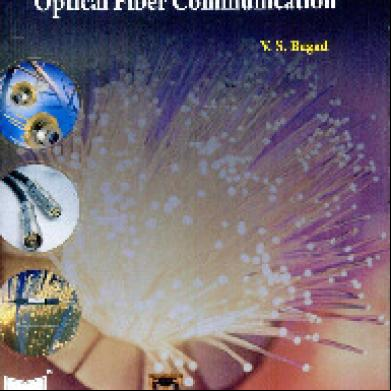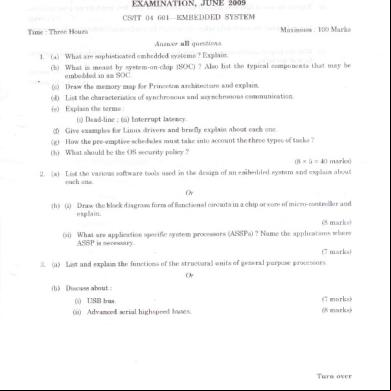Optical Fiber Communication Lab Manual Exp 1 l1z6b
This document was ed by and they confirmed that they have the permission to share it. If you are author or own the copyright of this book, please report to us by using this report form. Report 2z6p3t
Overview 5o1f4z
& View Optical Fiber Communication Lab Manual Exp 1 as PDF for free.
More details 6z3438
- Words: 589
- Pages: 3
Communication Lab- III
EC Deptt.
Fourth Year
HI-TECH INSTITUTE OF ENGG. & TECHNOLOGY EXPERIMENT-1 1.0 OBJECT Setting up fiber optics analog link and verification through voice signal transmission.
1.1 THEORY Fiber optics can be used for transmission of digital as well as analog signal. Basically a fiber optics link contains three main elements, a transmitter, optical fiber and receiver. The transmitter modules take the input signal in electrical form and then transform it into optical energy containing the same information. The optical fiber is the medium, which takes the energy to the receiver. At the receiver light is converted back into receiver into electrical form at the same pattern as to originally fed to the transmitter.
TRANSMITTER Fiber optics transmitters are typically composed of buffer, driver and optical source. The buffer provides both an electrical connection and isolation between the transmitter & the electrical system supplying of the data. The driver provide the electrical power to the optical source finally, the optical source converts.
The fiber optic link Emitter and detector circuit on board form the fiber optic link. This section provides the light detector at the far end of the fiber optic links. The optic fiber plugs into the connectors provided in this part of the board. Two separate links are provided.
1
Communication Lab- III
EC Deptt.
Fourth Year
HI-TECH INSTITUTE OF ENGG. & TECHNOLOGY The Receiver The comparator circuit, Low Filter, Phase Locked Loop, AC Amplifier circuit form receiver on the board. It is able to undo the modulation process in order to recover the original information signal. In this experiment the trainer board is used to illustrate One-Way communication between digital transmitter and receiver circuits.
1.3 Procedure 1) Connect the power supply to the board. 2) Make the following connections (a) Connect the output marked 1 KHz sine wave O/P to
(b) (c)
Buffer. Plug in a fiber optic link from O/P of emitter LED to the photo transistor of the detector. Detector O/P to input of amplifier.
3) In the emitter block switch the select to analog. 4) Turn the 1 KHz preset in function generator block to fully clock
wise (max. amplitude) position. 5) Switch on the power supply. 6)
With the help of dual trace oscilloscope observe the input signal at emitter. Also, observe the output from the detector. It should carry a smaller version of the original 1 KHz sine wave, illustrating that the modulated light beam has been reconverted back into an electrical signal.
7) The output from the detector is further amplified by AC amplifier. This amplifier increases the amplitude of the received signal, and also removes the DC component, which is present at detector O/P. monitor the O/P of amplifier and adjust the gain adjust preset until the monitored signal has same amplitude as that applied to emitter I/P. 2
Communication Lab- III
EC Deptt.
Fourth Year
HI-TECH INSTITUTE OF ENGG. & TECHNOLOGY 8) While monitoring the O/P of amplifier change the amplitude of
modulating sine wave by varying the 1 KHz preset in the function generator block. Note that expected, the amplitude of the receiver O/P signal changes. 9) Disconnect the emitter’s input to 1 KHz sine wave socket. 10)
11)
Make the following additional connections. (a) Audio I/P block’s I/P to microphone. (b) Connect the O/P of audio I/P block to emitters I/P. (c) AC amplifier’s O/P to I/P of audio output block. Switch on the power supply.
12) Observe that same audio output is available on the speaker as fed
to the microphone.
3
EC Deptt.
Fourth Year
HI-TECH INSTITUTE OF ENGG. & TECHNOLOGY EXPERIMENT-1 1.0 OBJECT Setting up fiber optics analog link and verification through voice signal transmission.
1.1 THEORY Fiber optics can be used for transmission of digital as well as analog signal. Basically a fiber optics link contains three main elements, a transmitter, optical fiber and receiver. The transmitter modules take the input signal in electrical form and then transform it into optical energy containing the same information. The optical fiber is the medium, which takes the energy to the receiver. At the receiver light is converted back into receiver into electrical form at the same pattern as to originally fed to the transmitter.
TRANSMITTER Fiber optics transmitters are typically composed of buffer, driver and optical source. The buffer provides both an electrical connection and isolation between the transmitter & the electrical system supplying of the data. The driver provide the electrical power to the optical source finally, the optical source converts.
The fiber optic link Emitter and detector circuit on board form the fiber optic link. This section provides the light detector at the far end of the fiber optic links. The optic fiber plugs into the connectors provided in this part of the board. Two separate links are provided.
1
Communication Lab- III
EC Deptt.
Fourth Year
HI-TECH INSTITUTE OF ENGG. & TECHNOLOGY The Receiver The comparator circuit, Low Filter, Phase Locked Loop, AC Amplifier circuit form receiver on the board. It is able to undo the modulation process in order to recover the original information signal. In this experiment the trainer board is used to illustrate One-Way communication between digital transmitter and receiver circuits.
1.3 Procedure 1) Connect the power supply to the board. 2) Make the following connections (a) Connect the output marked 1 KHz sine wave O/P to
(b) (c)
Buffer. Plug in a fiber optic link from O/P of emitter LED to the photo transistor of the detector. Detector O/P to input of amplifier.
3) In the emitter block switch the select to analog. 4) Turn the 1 KHz preset in function generator block to fully clock
wise (max. amplitude) position. 5) Switch on the power supply. 6)
With the help of dual trace oscilloscope observe the input signal at emitter. Also, observe the output from the detector. It should carry a smaller version of the original 1 KHz sine wave, illustrating that the modulated light beam has been reconverted back into an electrical signal.
7) The output from the detector is further amplified by AC amplifier. This amplifier increases the amplitude of the received signal, and also removes the DC component, which is present at detector O/P. monitor the O/P of amplifier and adjust the gain adjust preset until the monitored signal has same amplitude as that applied to emitter I/P. 2
Communication Lab- III
EC Deptt.
Fourth Year
HI-TECH INSTITUTE OF ENGG. & TECHNOLOGY 8) While monitoring the O/P of amplifier change the amplitude of
modulating sine wave by varying the 1 KHz preset in the function generator block. Note that expected, the amplitude of the receiver O/P signal changes. 9) Disconnect the emitter’s input to 1 KHz sine wave socket. 10)
11)
Make the following additional connections. (a) Audio I/P block’s I/P to microphone. (b) Connect the O/P of audio I/P block to emitters I/P. (c) AC amplifier’s O/P to I/P of audio output block. Switch on the power supply.
12) Observe that same audio output is available on the speaker as fed
to the microphone.
3










